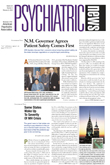Major depression is a frequent complication of traumatic brain injury (TBI) and is associated with psychiatric and neurological symptoms that hinder recovery.
Patients with major depression following TBI frequently exhibit comorbid anxiety and aggressive behavior, as well as executive dysfunction, poorer social functioning, and reduced left prefrontal gray matter volumes, according to Ricardo Jorge, M.D., and colleagues at the University of Iowa department of psychiatry.
The results of their prospective case-control surveillance study to determine the clinical, neuropsychological, and structural neuroimaging correlates of major depression occurring after TBI appeared in the January Archives of General Psychiatry.
In the study, 91 patients with traumatic brain injury were compared with 27 patients with multiple traumas but no evidence of central nervous system injury. Patients’ conditions were evaluated at baseline and at three, six, and 12 months after the traumatic episode. Psychiatric diagnosis was made using a structured clinical interview and DSM-IV criteria. Neuropsychological testing and quantitative magnetic resonance imaging were performed at the three-month follow-up visit.
Of the 91 patients with TBI, 47 (51.6 percent) developed a mood disorder during the first year after injury, compared with six (22.2 percent) of the 27 patients with multiple traumatic injuries but without central nervous system involvement. Thirty patients (33 percent) presented with major depressive features, nine (9.9 percent) had depression without major depressive features, and the remaining eight patients (8.8 percent) had manic or mixed features.
Of the 27 controls, two patients (7.4 percent) had major depressive disorder and four (14.8 percent) had depression without major depressive features.
The researchers found that major depression was associated with reduced gray matter volume in the lateral aspects of the left prefrontal cortex. Other studies of secondary depressive disorders have also found decreased metabolic rates in inferior frontal regions in patients with Parkinson’s disease, Huntington’s disease, and caudate stroke, the researchers noted.
They analyzed the effect of a history of anxiety or depressive disorders on frontal lobe volumetric measures and found no significant differences between patients with a history of depressive or anxiety disorders and patients without a history of psychiatric illness.
“We can also hypothesize that social deprivation and unemployment can be associated with prefrontal cortex changes,” Jorge and colleagues said. “However, unemployed patients did not show significant reductions in prefrontal volumes. In fact, patients with and without major depression who were unemployed had higher prefrontal volumes than their employed counterparts. Thus, there is no evidence to support the idea that asymmetric differences in frontal lobe volume pre-existed the brain injury, and we believe that the decreased left frontal lobe volume is the result of resolving traumatic lesions approximately three months after the TBI occurred.”
Constantine Lyketsos, M.D., chair of APA’s Corresponding Committee on Psychosomatic Medicine, said in an interview with Psychiatric News that the public health burden of traumatic brain injury is substantial and that the study by the Iowa researchers underscores the importance of collaboration between specialists in neurology, rehabilitation medicine, and psychiatry.
“There are hundreds of thousands of new head injuries of moderate severity or greater every year,” he said. “Most of the time, people with head injuries recover and live with the consequences of brain damage, including psychiatric disorders that make recovery harder.”
Lyketsos is a professor of psychiatry and behavioral sciences and co-director of the division of geriatric psychiatry and neuropsychiatry at Johns Hopkins University School of Medicine in Baltimore.
This study was supported in part by grants from the National Institute of Mental Health.
Arch Gen Psychiatry 2004 61 42
